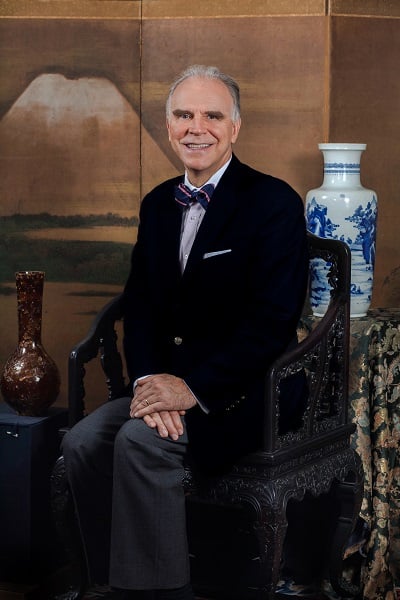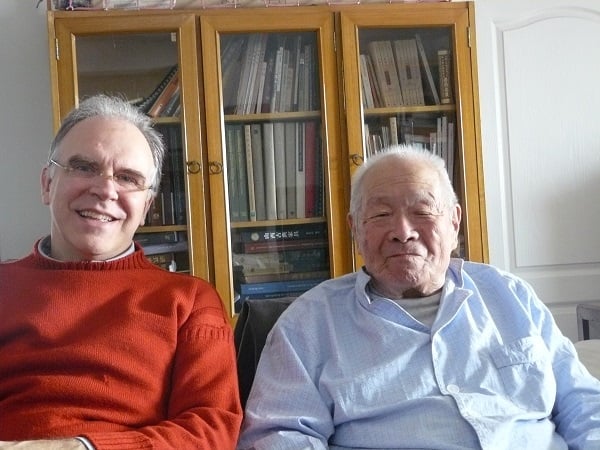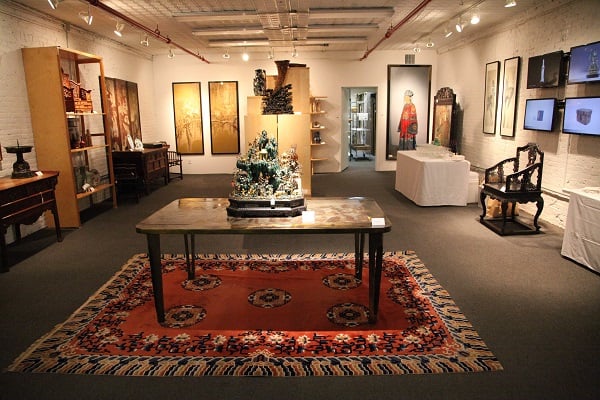Auctions
Q & A with Antique Expert: Lark Mason
An interview with Lark Mason, an expert in the field of auctions and antiques.

An interview with Lark Mason, an expert in the field of auctions and antiques.

Lark Mason is an expert in the field of auction and antiques. He is the author of Asian Art: Including the Arts of Islam, an acclaimed art history guide, and translator of two groundbreaking works on Chinese furniture. Mason spent 17 years as an Asian Art appraiser on Antiques Roadshow, and worked for 24 years at Sotheby’s New York, where he served as a generalist, senior vice president in the Chinese works of art department, and director of online auctions. In 2003, he started his own business, an international Fine Art and antiques auction site called iGavel.com.

Lark Mason
Helen Bu: On you profile for the PBS series, Antiques Roadshow, I read that you started out in the antique business at an early age. What fascinates you about this industry?
Lark Mason: I became interested in antiques at an early age because of the association of objects with history; not in a dry sense, such as in a book of dates and events, but in a real, physical, tangible sense. The idea of an object, created a generation or more before I was born, having value to someone, intrigued me. I wondered why someone went to the trouble to create an object in the first place, how that object was used, and then why it survived. It fascinated me that objects without a practical use have value. I discovered that objects tie the living to generations that are past, and in the process tell us something about them and about us. Objects also are repositories of skills that have changed and in some instances disappeared. Understanding these processes led to an appreciation for ingenuity and craftsmanship that became the basis for learning the difference between objects made at different time periods and locations.
HB: You are most renowned as an expert in Asian Art and antiques, especially Chinese Art. Was that always your main focus? What brings you into this field?
LM: My interest originally was not with Asian or Chinese Art but with swords, militaria, and early books. During college, my interests changed as I opened an antique shop selling American country and English 18th-century furniture and decorations. I realized after my first year that I needed more experience, which led me to spend a year at Sotheby’s Works of Art Program in London from 1978 to 1979. It was there that I first was exposed to Chinese Art. I remember my first encounter with Chinese Art in the British Museum; I was amazed at the quality and perfection of porcelain created during the early Ming dynasty. Later, I was close to overwhelmed at the Perceval David Collection in London. The ceramic shapes and colors created by the Song potters were as new and fresh today as when they were created over 800 years earlier. After six years as a generalist appraiser for Sotheby’s in New York, working with all types of arts and antiques, I finally landed in the Chinese department, where I stayed until 2003.
HB: I know that you’ve had the opportunity to work with Wang Shixiang (Chinese, 1914–2009), who is reputed as a Chinese culture master, in translating his book, Connoisseurship of Chinese Furniture, back to the 1980s in Beijing. How was that experience? What were your impressions of Wang and Beijing at that time?
LM: Beijing in the late 1980s had more in common with the pre-World War II period than today. It was a time capsule. The building boom had yet to start, and Beijing was still a city with neighborhoods full of Ming and Qing buildings. Every day, I tried to bicycle through different parts of the city. I arrived at Shixiang’s courtyard house around 9 a.m. and we sat across from each other working on a dark, polished zitan painting table. To one side was an open window looking out on the courtyard with a variety of ragged plants and a banana palm, and the other was framed by stacks of books and his collection of crickets. We worked across from each other for six months. Each day around noon, I went back to my dormitory and retyped my notes and had lunch, and then I would ride my bicycle back by 3 p.m. We would work for another three hours, and then he and his wife would often share dinner with me. He was a fantastic cook and delighted in sharing recipes that had been favorites of the court. Seas of commuters filled the streets each morning and afternoon, but then the streets were completely empty by 8 p.m. There were no cars except those near the few western hotels. I remember the first time I heard flocks of pigeons flying overhead with pigeon whistles attached to their bodies. It was an amazing sound. That world is gone and I was privileged to experience it.

Lark Mason and Wang Shixiang
HB: After making regular appearances as an appraiser on Antiques Roadshow for over 17 years, I’m sure you have many entertaining stories. Could you please share a memorable one with us?
LM: The most memorable stories are not always those of the most valuable items. I remember very early on in the series we were in a southern city and the day was long and slow. Finally a man in his 30s came in with a small celadon jade vase. In the early days of the show, there were no tickets and the audiences were small. On this particular day, this man had stopped by at a garage sale on the way home for his anniversary or wife’s birthday, I cannot remember which. He had forgotten this important date and bought a jade vase at a garage sale to hold the flowers that he was going to buy at a local shop. He saw that the Roadshow was in town and stood in line to find out about it. I don’t recall what he paid, but it was under US$20. I told him that it was from the late Qing dynasty and worth around 20 times that amount. Of all days to stop at a garage sale, he picked the one day that someone could tell him about a jade vase. Had he made this purchance on any other day, he would never have known the value of this special gift.
HB: In 2003, you left Sotheby’s and started your own business, iGavelauctions.com. Why is it solely online? What differentiates it from other online platforms? What are your thoughts about the future for an online art marketplace?
LM: I actually have two businesses. iGavel is an auction platform that is used by independent auction houses whose sales are hosted on the iGavel site. In addition, I own Lark Mason Associates, an auction house that uses the iGavel platform. Lark Mason Associates regularly sells on iGavel and focuses on Asian Art. The difference between iGavel and other platforms is that all of our bidding is online, allowing us to implement policies that most auctioneers cannot. We publish the reserves so that everyone knows the minimum amount, we offer a two-week bidding window, we offer a consistent experience for all users of our site, and we provide plenty of information to make a decision, including guaranteed condition reports and lots of photographs. We also have live exhibitions so that people who wish to view items in person are able to do so. Auction houses with a combination of live bidding and an Internet component leave the online bidder at a disadvantage to the bidder in the salesroom. Our service keeps all bidders at the same level, and, as a result, we end up with a higher percentage of retail-type buyers participating in our sales than is the case with other auction houses.

iGavel’s gallery space
HB: George Bailey, one of Sotheby’s leading figures in Europe, recently launched his own business, an online-only auction house called The Auction Room, which he said will target the middle range of the market. Is the middle market a focus of iGavel as well? If so, what potential do you see in this section?
LM: George and I both understand that the area that is most underserved in the art business is the middle market. It is also the most difficult in which to make a profit. The art auction market is stratified by price like a pyramid. The top of the market is at the tip, with a small audience of international bidders competing for a few objects. The lowest part of the pyramid is the largest, and is composed of the many local tags and estate sales that occur daily throughout the world. The middle market, unlike the lower end material, appeals to an international audience. The problem is how to reach that audience in an affordable manner. Middle market items benefit from wider exposure, but the cost to reach potential bidders using a traditional approach of mailers and catalogs is costly and inefficient. The Internet is the only medium that can reach an international audience in a cost-efficient and targeted manner, and can provide enough information so that the bidder can make an informed decision. The challenge with the middle market is in reaching the audience and keeping the transaction and fulfillment costs at a level that enables the auctioneer to make a reasonable profit, the consignor to receive more than would otherwise be the case, and the purchaser to receive the item without paying a disproportionately high amount for shipping. George is targeting the middle market like we are, because this is an area with ample growth opportunities. We bring to an auction an audience of individuals who would otherwise not participate if our format were more traditional.
HB: You once told collectors of Asian Art that they should try “to identify new or under-collected areas.” Are there any such areas that caught your attention recently?
LM: The market for Asian Art and specifically Chinese Art is incredibly dynamic. Emerging economies in Asia are creating newly wealthy individuals who want to use their discretionary income to buy objects with which they have a cultural resonance. Not all people are going to buy art and antiques, but in any society a percentage will, and the demographics of Asia are such that even when a small segment of the population “discovers” a particular category or subject, it results in hundreds of thousands of individuals entering the market. China is unique in Asia because of its history of craftsmanship and production of works of art for all strata of society, which results in lots of objects. The historically-large population and the cultural affinity for owning works of art result in all types of new areas of collecting. It is not an area that is new, but I particularly like objects made of wood; there are many small utilitarian objects created for everyday use in China and in other cultures that appeal to me.
HB: What do you usually do in your spare time? Do you collect art yourself?
LM: I do not consider myself a collector but am fortunate to have some nice objects that my wife and I have picked up over the years. We like to share those with other people, and I enjoy puzzling out the reasons for an item being created and understanding the difficulties faced by the person who created the object. In our free time, we garden and travel, and spend time with members of our Church community. We enjoy serving others and being hosts, and our house is often full of guests. We have had the privilege of regularly hosting university mission trips of students coming to New York to work with non-profit groups. We enjoy the interaction with the students and provide a place for them to stay. Seeing 20 to 30 students curled up in sleeping bags across our living and dining areas is a wonderful experience. Traveling for the Roadshow during the summer offers a chance to reconnect with friends. We try to stay in historic hotels in out-of-the-way locations.